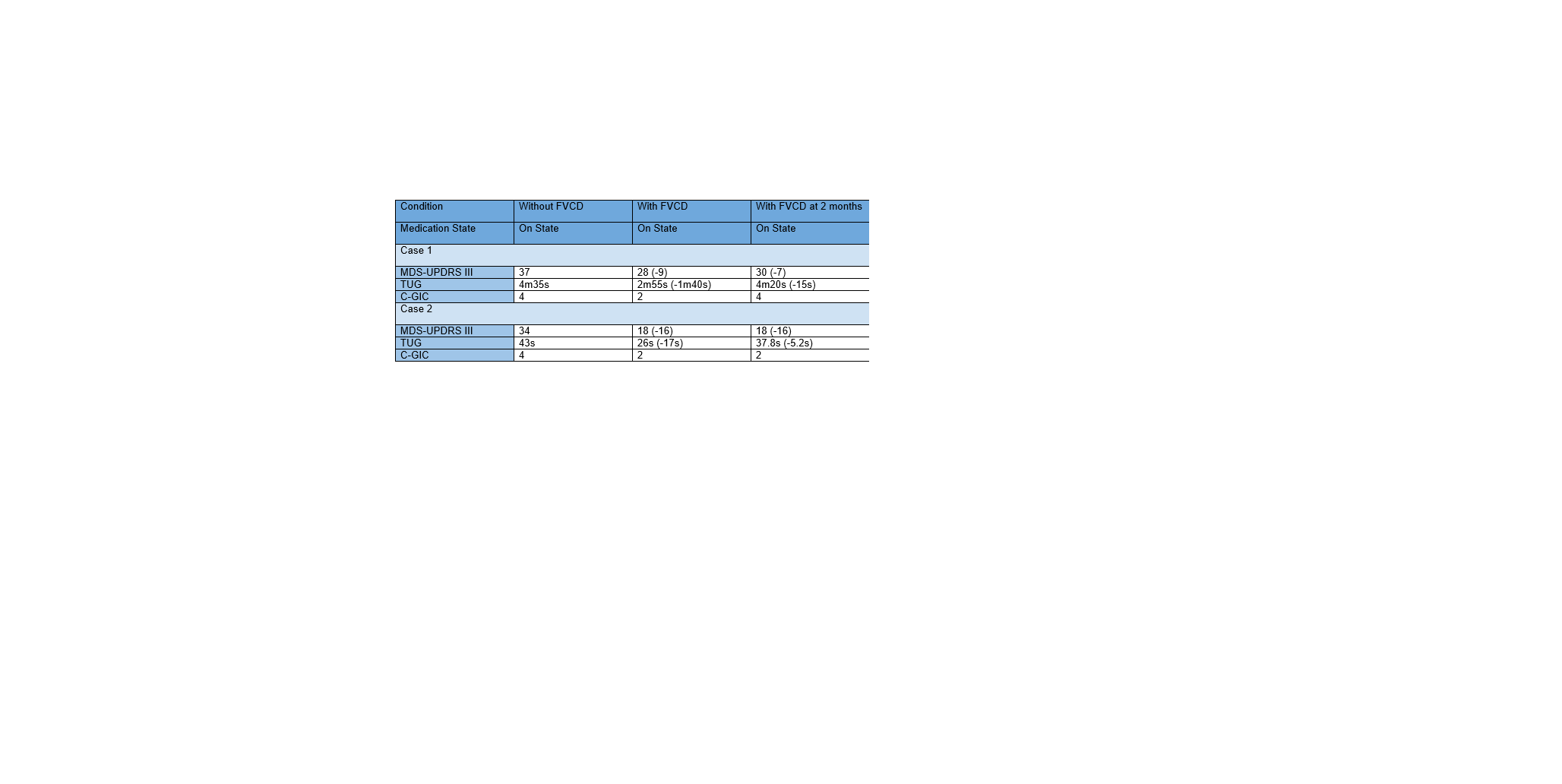Objective: To assess the use of Focussed Vibrotactile Stimulation and Cueing Device (FVCD) in two patients with Parkinson’s disease (PD)
Background: We present two patients with motor symptoms including Freezing of Gait (FOG) despite efforts to optimize their medication. Recent studies on high-frequency vibrotactile stimulation have shown improvement in motor tasks and reduction in beta-wave synchronicity [1]. In addition to this, the use of external cueing as a treatment for FOG has been extensively studied and deployed in clinical practice [2,3]. The FVCD combines the two methods of non-invasive peripheral stimulation with the aim of improving motor symptoms in Parkinson’s disease.
Method: Two patients were recruited from the movement disorder clinic and consented to participate. They were invited to Complejo Hospitalario Dr. Arnulfo Arias for the study. The first patient was a 77 year old male (Case 1), and the second was a 73 year old male (Case 2). They had both been established on Levodopa. They were evaluated on three occasions in their ‘on state’. The initial assessment was with the stimulus worn but inactive, immediately after the device was activated, and 2 months later. MDS-UPDRS III and Timed Up-and-Go (TUG) and Clinical Global Impression of Change (CGI-C) [4] were performed on the two visits.
Results: In the 77-year-old patient, the initial MDS-UPDRS part III was 37, immediately after the device was activated the score was reduced to 28 and 30 after 2 months. The initial TUG was 4 minutes and 35 seconds, immediately after FVCD activation was 2 minutes and 55 seconds and after the 2 months 4 minutes with 20 seconds. The CGI-C was 2 (much improved) on immediate use of the FVCD, and 4 (no change) at 2 months. In the 73-year-old patient, the initial MDS-UPDRS was 34, immediately after FVCD activation was 18, and 18 after 2 months. The initial TUG was 43 seconds, immediately after FVCD was activated 25.96 seconds, and 37.8 seconds after 2 months. The CGI-C was 2 (much improved) on immediate use of the FVCD, and 2(much improved) at 2 months.
Conclusion: Improvement in both the MDS-UPDRS part III and TUG was seen on immediate activation and 2 month follow-up. This improvement was greater than the Minimally Clinically Important Difference (MCID) of -3.25 [5]. FVCD may improve motor symptoms of Parkinson’s and warrants further research in the field of peripheral non-invasive neuromodulation
References: 1] Macerollo, A., Palmer, C., Foltynie, T., Korlipara, P., Limousin, P., Edwards, M., & Kilner, J. M. (2018). High‐frequency peripheral vibration decreases completion time on a number of motor tasks. European Journal of Neuroscience, 48(2), 1789-1802.
[2] Wilhelm, A., Riedl, T., Paumann, C., & Janssen, J. (2022). Exploring a New Cueing Device in People Who Experience Freezing of Gait: Acceptance of a Study Design. Parkinson’s Disease, 2022.
[3] Tan, XS., Pierres, F., Dallman-Porter, A., Hardie-Brown, W., Kwon K-Y. Focused Vibrotactile Stimulation with Cueing Effect on Freezing of Gait in Parkinson’s Disease: Two Case Reports. J Mov Disord 2021;14(3):236-238
[4] Dashtipour, K., Chen, J., Dalaie, P., Frei, K., Kani, K., Kani, C. (2015). Correlation between Unified Parkinson’s Disease Rating Scale and Global Impression of Change Scales. American Academy of Neurology 67th Annual Meeting, 2015; 84 (14 Supplement)
[5] Horváth, K., Aschermann, Z., Ács, P., Deli, G., Janszky, J., Komoly, S., & Kovács, N. (2015). Minimal clinically important difference on the Motor Examination part of MDS-UPDRS. Parkinsonism & related disorders, 21(12), 1421-1426.
To cite this abstract in AMA style:
R. Rodriguez, L. Pinilla, J. Villarreal. First Case Series on the use of a High Frequency Vibrotactile Stimulation and Cueing Device in Panama [abstract]. Mov Disord. 2023; 38 (suppl 1). https://www.mdsabstracts.org/abstract/first-case-series-on-the-use-of-a-high-frequency-vibrotactile-stimulation-and-cueing-device-in-panama/. Accessed December 22, 2025.« Back to 2023 International Congress
MDS Abstracts - https://www.mdsabstracts.org/abstract/first-case-series-on-the-use-of-a-high-frequency-vibrotactile-stimulation-and-cueing-device-in-panama/

